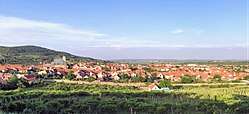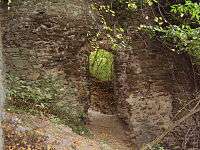Svätý Jur
Svätý Jur (Slovak pronunciation: [ˈsvæti: jur] (![]()
Svätý Jur Sankt Georgen | |
|---|---|
Town | |
 Panorama view | |
 Flag | |
 Svätý Jur Location of Svätý Jur in the Bratislava Region  Svätý Jur Svätý Jur (Slovakia) | |
| Coordinates: 48°15′07″N 17°12′56″E | |
| Country | |
| Region | Bratislava |
| District | Pezinok |
| First mentioned | 1209 |
| Government | |
| • Mayor | Šimon Gabura |
| Area | |
| • Total | 39.874 km2 (15.395 sq mi) |
| Elevation | 180 m (590 ft) |
| Population (2018-12-31[1]) | |
| • Total | 5,700 |
| • Density | 140/km2 (370/sq mi) |
| Time zone | UTC+1 (CET) |
| • Summer (DST) | UTC+2 (CEST) |
| Postal code | 900 21 |
| Area code(s) | +421-2 |
| Car plate | PK |
| Website | www.svatyjur.sk |
Today, Svätý Jur has a population of over 5 thousand citizens. The town is well connected with a major road between Pezinok and Bratislava passing through and the Svätý Jur railway station situated on the main Košice - Bratislava railway line. The city is bordered by the Little Carpathian mountains to the west, Bratislava to the south, natural reserve Šúr to the east and Limbach and Pezinok to the north and northeast respectively.
Etymology
The city name translates literally as Saint George, Jur being the archaic form of Juraj in the Slovak language. Between 1960 and 1990, the Communist government renamed the town to Jur pri Bratislave.
Geography
Svätý Jur is situated in the Pezinok District of the Bratislava Region in southwestern Slovakia. The surrounding areas include large vineyards in the nearby Little Carpathians and the unique Šúr swamps, a protected area.
History
Archaeological excavations date the original settlement to the Hallstatt period and the Quadi period.
In the 9th century, a Great Moravian castle was built here. Svätý Jur was first mentioned in a written source in 1209 and received a town charter in 1299. It became a royal free town in the Kingdom of Hungary in 1647.
Defensive city walls were constructed between 1603 and 1664, but Svätý Jur was devastated by the Ottoman Turks in their invasion of 1663. The Ottoman troops also destroyed the White Castle (Slovak: Biely Kameň), which had been an important administrative center of the region until then.
In the 18th century, the Hungarian government recruited German farmers to repopulate the area. To encourage migration, it allowed the Germans to keep their language and religion in order to develop farmland for cultivation and produce. Through the 19th century and into the 20th century, the population of this area was largely ethnic German, although by that time they spoke an archaic form of German. They were known as Danube Swabians. In part because Nazi Germany used the eastern ethnic German communities as an excuse for its wars of expansion in eastern Europe, after World War II, ethnic Germans were forcefully expelled to Germany and other Western countries.
In 1840, the first (horse) railway in the Kingdom of Hungary was built from Bratislava to Svätý Jur.
Landmarks
The most remarkable historical monument is the Gothic church of St. George, built in the 13th century. The sandstone altar from 1527 is an example of a transition between the Gothic and Renaissance styles. The stained glass windows were designed by Janko Alexy in 1950. The wooden bell tower from the 17th century protects a bell from 1400. The bell cracked due to a fire in 1802 and after repair in 1848 was damaged again. There is a fame that this bell was buried during the period of the Ottoman raids and was accidentally found by a rooting pig afterwards.
A Great Moravian castle was built in the 9th century and it was abandoned in the 14th century. 1,693 metres of the walls have been preserved, but their height is now lower than the original 10 metres.
Other places of interest include a Renaissance manor house, a Baroque church of Trinity, a Piarist monastery from 1720, a late 18th century synagogue and the ruins of the city walls.
Svätý Jur is also well known for the largest raceway in Slovakia.
Biely Kameň Castle

The castle of Biely Kameň was mentioned for the first time in 1217.
It was the seat of the counts of Svätý Jur until 1609, when they moved to a more comfortable manor house in the town. The castle was partially destroyed by an Ottoman raid in 1663.
The ruins are still visible.
Population
In 2006, Svätý Jur had a population of 5,186. According to the 2001 census, 97.5% of inhabitants were Slovaks. The Roman Catholicism is the most popular religion (72.5%), but there is also a significant number of atheists (15.9%) living in the village.[2]
Sport
The town has an association football team called ŠK Svätý Jur.
Famous people
- Alojz Hudek (1887 – 1961), SDB, Roman Catholic priest end Missionary (Bolivia, Peru).[3]
Twin towns — sister cities
Svätý Jur is twinned with:[4]

References
- "Population and migration". Statistical Office of the Slovak Republic. Retrieved 2019-04-16.
- http://www.statistics.sk/mosmis/eng/run.html Municipal Statistics from the Statistical Office of the Slovak republic
- KUBANOVIČ, Zlatko: Historický náhľad do dejín slovenských saleziánov (Od dona Bosca do roku 1924). Bratislava : Don Bosco, 2019. ISBN 978-80-8074-436-6. S. 245 – 246.
- "Partnerská města". mubela.cz (in Czech). Bělá pod Bezdězem. Retrieved 2019-09-04.
External links
![]()

